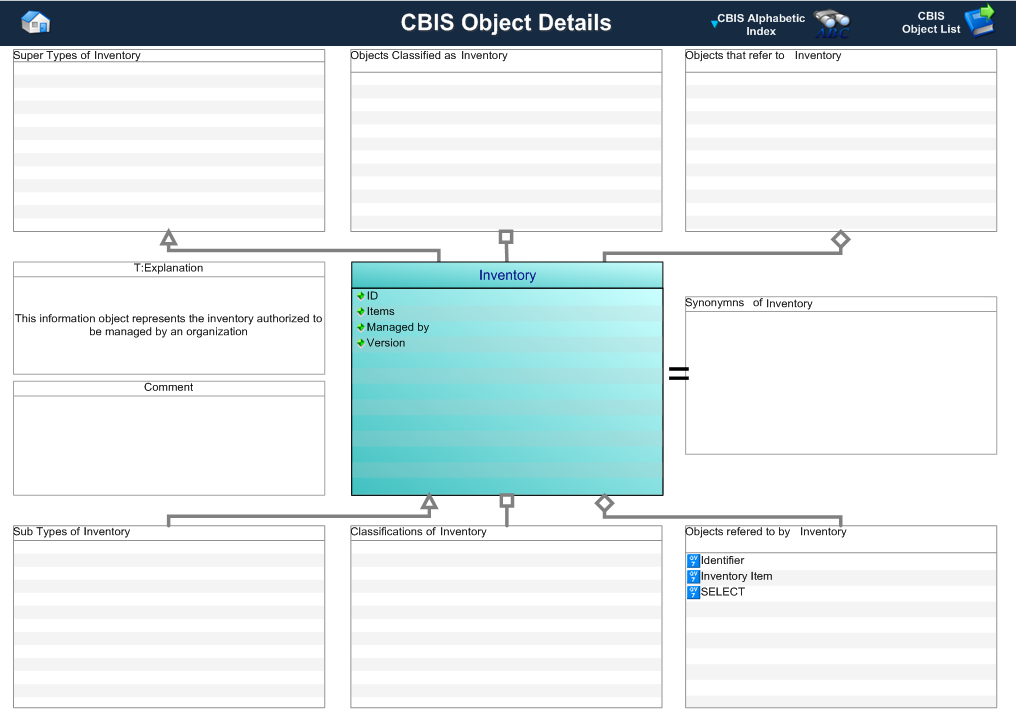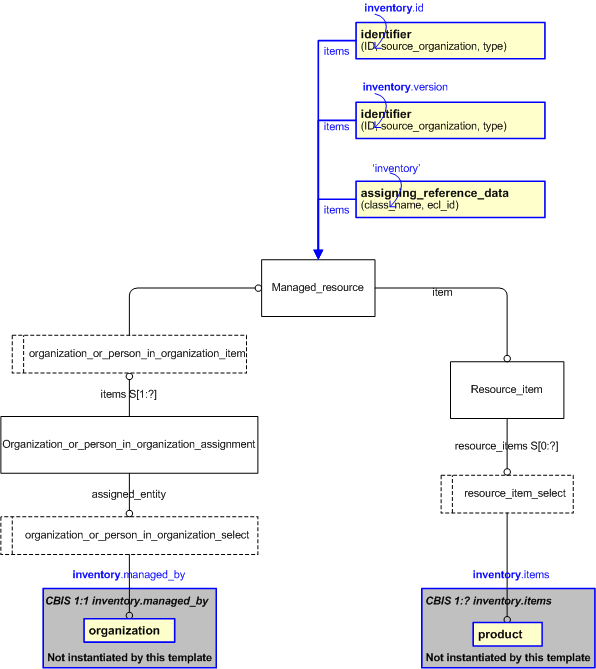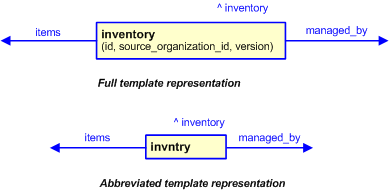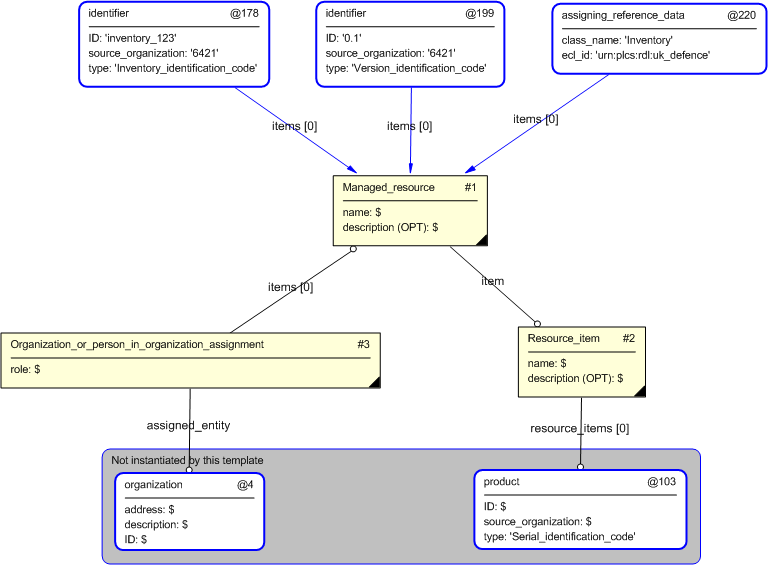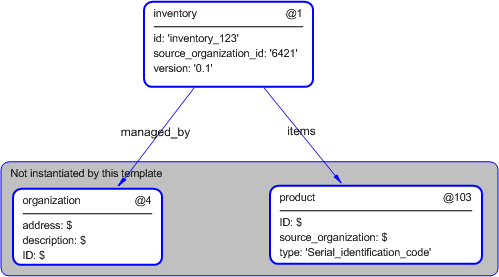Template:— inventory (invntry)
Context:— UK_Defence |
Date: 2009/04/17 09:34:16
Revision: 1.6
|
This section specifies the template inventory.
NOTE
The template has been defined in the context of
UK_Defence.
Refer to the business context for details of related templates.
NOTE
An explanation of a template and the associated instantiation path is
provided in the
Template overview
section.
This template describes how to represent the inventory authorized to be managed by an organization.
A Facility Demand is the means to represent the inventory authorized to be managed by an organization.
Figure 1 — Graphical Representation for Business Object inventory
inventory
The definition of an inventory object is:
This information object represents the inventory authorized to be managed by an organization.
|
Attribute name
|
Attribute description
|
Attribute type
|
Optionality
|
| ID |
This is the identifier of the inventory. |
Identifier |
Mandatory |
| Identifier.id |
This is the value of the id attribute of the Identifier applied to the inventory. |
intrinsic |
Mandatory |
| Identifier.type |
This attribute is the type associated with the id of the Identifier given to the inventory. |
inventory_id_code |
Mandatory |
| Identifier.source_organization |
This attribute is the value representing the source organization that provides the id of the Identifier given to the inventory.
This value is assumed to be a type of Organization_identification_code.
|
Organization_identification_code |
Mandatory |
| Items |
This is a reference to the items managed within the inventory. |
Relationship to Inventory Item |
Mandatory (1:?) |
| Managed by |
This is the organization or person responsible for managing the inventory. |
Relationship to Organization or Person |
Mandatory |
| Version |
This represents the version of the inventory. |
intrinsic |
Mandatory |
Table 1 — inventory attribute details
The EXPRESS-G diagram in
Figure
2
shows the templates and EXPRESS entities that are required
to represent the template
"inventory".
The text highlighted in blue shows the template parameters.
Figure 2 — An EXPRESS-G representation of the Information model for inventory
The graphic for the template to be used in other EXPRESS-G diagrams
is shown in Figure
3
below.
Figure 3 — The graphical representation of the inventory template
The following input parameters are defined for this template:
The identifier assigned to the inventory item
The organization providing the identifier to the inventory item.
The identifier assigned to the inventory item
This is the organization or person responsible for managing the inventory.
This is a reference to the items managed within the inventory.
The following reference parameters are defined for this template:
Allow the
Managed_resource
entity instantiated in this path to be referenced when this template is used.
%^target = $inventory.inventory%
The instantiation path shown below specifies the entities that are to be
instantiated by the template.
A description of templates and the syntax for the instantiation path is
provided in the
Templates Help/Information section.
-- create the inventory_item %^inventory =
Managed_resource%
^inventory.name = '/IGNORE'
^inventory.description = '/IGNORE'
-- Note the optional Managed_resource.quantity attribute is left unused -- create the associated resource_item %^inventory_items =
Resource_item%
^inventory_items.name = '/IGNORE'
^inventory_items.description = '/IGNORE'
^inventory_items.resource_items ->
@items-- Note the opt resource_items cannot relate back to the managed_resource of Inventory_item, but is able to link to the 'actual'
product, spec etc., that these items refer to. -- Associate the Resource_item above with the Inventory (Managed_resource)
^inventory.item ->
^inventory_items
-- Inventory item id /
identifier(
ID=@id,
source_organization=@source_organization_id,
type='Inventory_identification_code',
items=^inventory)/
-- Inventory item version /
identifier(
ID=@version,
source_organization=@source_organization_id,
type='Version_identification_code',
items=^inventory)/
-- not explicitly required but may need to classify different Managed resource instances. /
assigning_reference_data(
class_name='Inventory',
ecl_id='urn:plcs:rdl:UK_Defence',
items=^inventory)/
-- Managed_by Organization_or_person_in_organization_assignmentOrganization_or_person_in_organization_assignment.role = '/IGNORE'
Organization_or_person_in_organization_assignment.items ->
^inventory
Organization_or_person_in_organization_assignment.assigned_entity ->
@managed_by
The following entities are instantiated with attributes as specified:
The instance diagram in Figure
4
shows an example of the EXPRESS entities and templates that are instantiated by the template:
/inventory(id='inventory_123', source_organization='6421', version='0.1', managed_by='#4', items='#103')/
(an illustration of the consolidated inventory template is shown in
Figure
5 below.)
Figure 4 — Entities instantiated by inventory template
The instance diagram in
Figure
5
shows the graphic symbol for the template that is to be
used in other instance diagrams. The example template is:
/inventory(id='inventory_123', source_organization='6421', version='0.1', managed_by='#4', items='#103')/
Figure 5 — Instantiation of inventory template
Characterizations
No common characterizations of the template
inventory
have been identified. However, the ISO 10303-239 EXPRESS model
may enable other assignments to the entities instantiated by the template.
